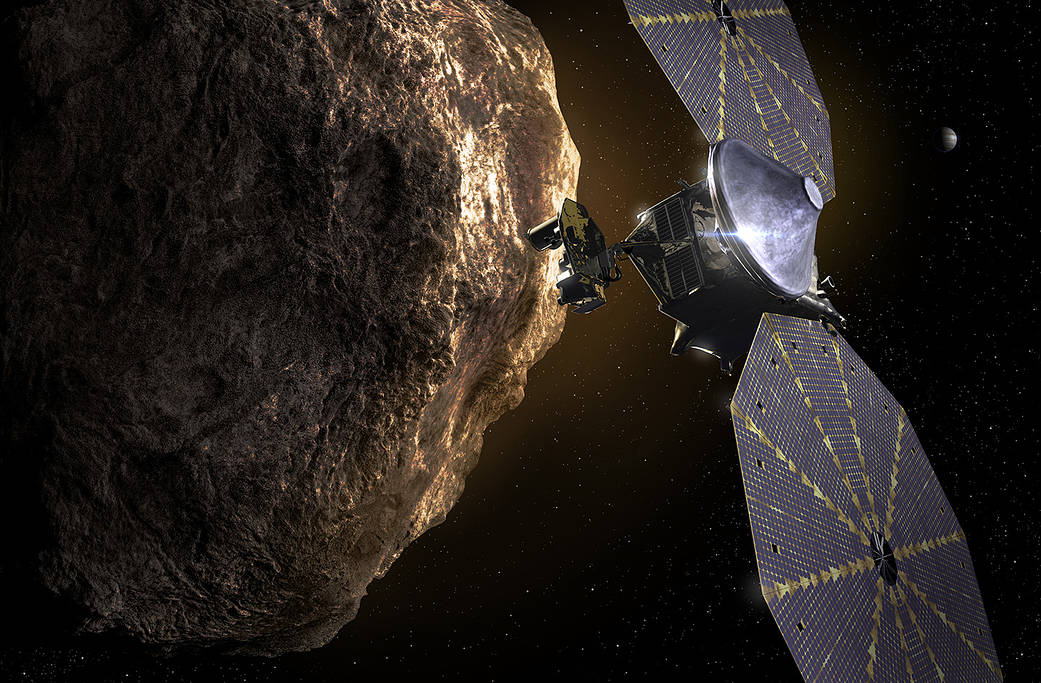
NASA is ready to launch a $981 million mission to the distant reaches of the solar system Saturday, kicking off a 12-year expedition to visit a group of unexplored asteroids that may offer clues to help scientists decipher how the planets formed more than 4 billion years ago.
The Lucy mission, NASA’s latest solar system explorer, will leave Earth to begin a series of ever-larger orbital loops around the sun, eventually reaching the distance of Jupiter in 2027. Then the mission will fly by five asteroids in 15 months before taking another lap around the sun, setting up for a final flyby of a binary pair of asteroids in 2033.
“This mission is going to study a population of objects called the Trojan asteroids, which lead or follow Jupiter in its orbit by 60 degrees,” said Hal Levison, Lucy’s principal investigator from the Southwest Research Institute, or SWRI, in Boulder, Colorado. “The reason why they’re important scientifically is they were leftovers.
“The way we think of them are as fossils, which is why we named the Lucy spacecraft after the human ancestor fossil known as Lucy,” Levison said in an interview with Spaceflight Now. “This is going to tell us how the giant planets formed and how they moved around.”
Built by Lockheed Martin in Colorado, the 3,300-pound (1,500-kilogram) Lucy spacecraft is tucked inside the nose cone of a United Launch Alliance Atlas 5 rocket at Cape Canaveral Space Force Station. Blastoff from launch pad 41 is scheduled for 5:34 a.m. EDT (0934 GMT) Saturday, the opening of a 75-minute launch window.
There’s a 90% chance of good weather for liftoff Saturday, according to the U.S. Space Force weather team at Cape Canaveral.
The mission has 23 days to blast off and take advantage of a unique alignment between Earth and the asteroids in the outer solar system.
If something prevents launch this year, NASA has a backup opportunity to launch Lucy in October 2022 without any impact to the mission’s science goals.
The Atlas 5 rocket’s payload shroud, produced by ULA in Harlingen, Texas, is emblazoned with the Lucy mission logo. The insignia features a pictorial illustration of the fossilized remains of a human ancestor, called Lucy by the scientists who discovered her in Ethiopia in 1974.
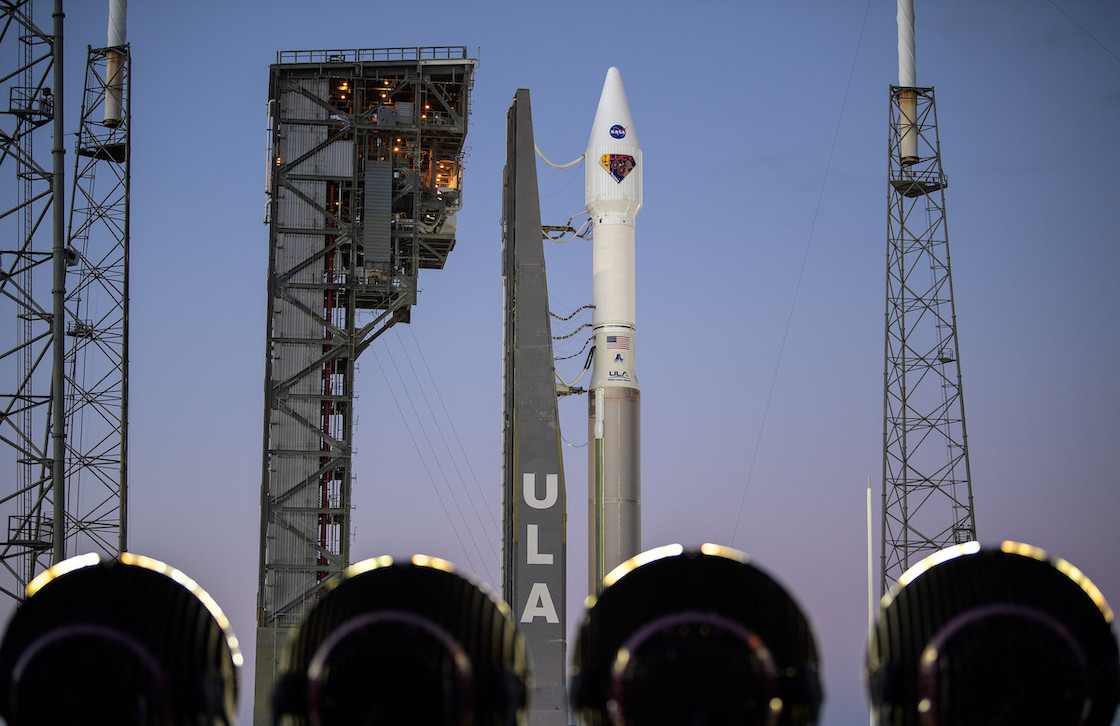
Lucy is the first mission to fly through the Trojan asteroid swarms.
Scientists believe the Trojan asteroids represent a diverse sample of the types of small planetary building blocks left behind after the solar system formed 4.5 billion years ago. Lucy will fly by eight different asteroids from 2025 through 2033, including seven in the Trojan swarms.
“These objects are interesting because they are the remnants from solar system formation,” said Cathy Olkin, deputy principal investigator for the Lucy mission at SWRI. “We’ve designed our mission to investigate the diversity of these objects in this population. We are going to be visiting the most asteroids ever with one mission. We’re going to be flying past seven Trojan asteroids in this epic journey of nearly 4 billion miles. We’re going to study the geology, surface composition … and we’re going to search for satellites around these objects.”
Like the fossil discovery that informed scientists about human evolution, the Trojan asteroids could provide clues about the solar system’s ancient history. After Jupiter formed and settled into its current orbit, the asteroids became trapped in swarms, each centered on a gravitationally-stable libration point ahead of and behind the solar system’s biggest planet.
“That fossil transformed our understanding of hominid evolution, just like we hope that the Lucy spacecraft will transform our understanding of solar system,” Olkin said.
NASA selected the Lucy mission, along with another asteroid explore named Psyche, for development in 2017. Psyche is scheduled to launch next year to orbit a metal-rich asteroid.
Lucy and Psyche, sometimes called sister missions, will visit different types of objects. But both could tell scientists much about the evolution of the solar system.
The two deep space probes join NASA’s line of cost-capped Discovery missions, a program that has included the Mars Pathfinder rover, the Messenger mission to orbit Mercury, and the Dawn spacecraft that orbited the giant asteroid Vesta and the dwarf planet Ceres.
Picked from a slate of 28 proposals submitted to NASA in 2015, Lucy and Psyche will visit worlds never before seen close-up as scientists seek to sort out the violent early history of the solar system, when proto-planets coalesced from mergers and collisions between rocks and boulders in a disk around the sun.
The Trojan asteroids, including Lucy’s flyby targets, may still look the same as they did more than 4 billion years ago, before scientists believe the immense pull of Jupiter’s gravity trapped them in their current locations as the outer planets shifted positions. The Trojans are relics of the types of objects that came together to create the giant planets: Jupiter, Saturn, Uranus, and Neptune.
Because of their distance from Earth, fragments from the Jupiter Trojans have never fallen to the ground as meteorites, robbing scientists of any insight into their history and make-up.
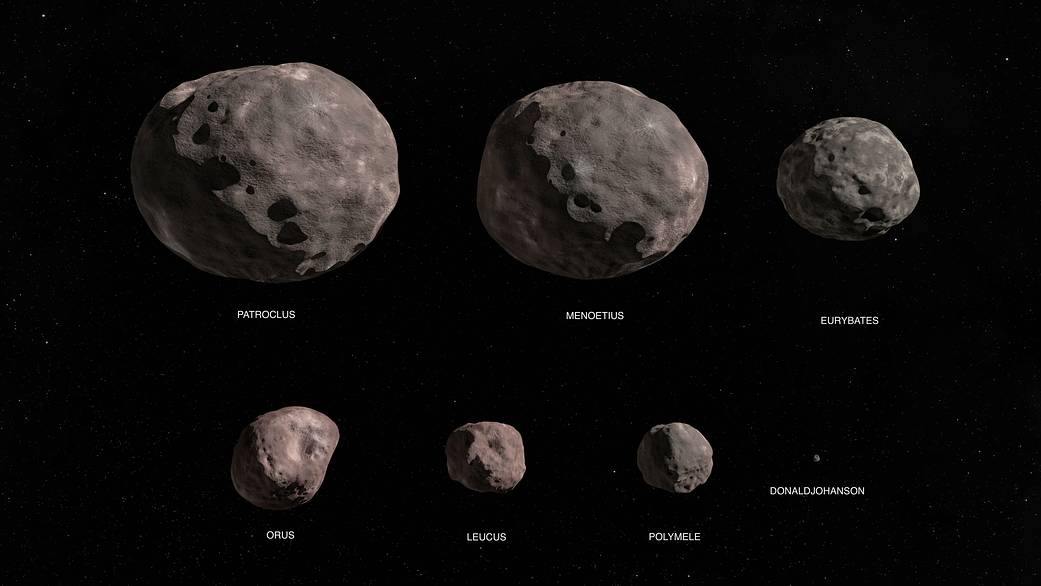
“If all this story is true … these objects really do represent objects that formed throughout the outer solar system, and are now in the Trojan swarms, where a mission like Lucy can go and study them,” Levison said.
Scientists know little about the Trojan asteroids. Astronomers have found more than 7,000 objects. There may be thousands more awaiting discovery using large telescopes.
But even the Hubble Space Telescope can’t resolve details about the composition and appearance of the Trojan asteroids. Scientists have a rough approximation of the size of each object to be visited by Lucy, and know a bit about their colors. Some are gray, and some are more reddish in appearance.
“This is a mission of exploration,” Olkin said. “We haven’t seen the Trojan asteroids before. One thing we’re looking at is the composition. So a lot of things are clues, but we don’t have a specific hypothesis that we’re testing that I can tell you, yes or no, because we’ve never been to these objects before. There are lots of questions we have, and we need to continue learning to be able to ask the next deeper level of questions.”
Lucy’s targets in the Trojan swarms range in size from less than a mile wide to more than 60 miles in diameter.
“We’re sampling different sizes of objects, different spectral types, two different swarms, so we’re looking at diversity across every different axis that we can think of,” Olkin said. “So we can take this mission, visit the most asteroids ever, and be able to really compare these objects.”
The largest of Lucy’s asteroid targets, named Patroclus and Menoetius, will be the last worlds visited during the mission. Ground-based observations indicate those asteroids are roughly spherical in shape.
At the same time teams are readying the Lucy spacecraft for launch, astronomers are trying to learn more about the shapes of the mission’s other targets. Scientists use stellar occupations, when something passes directly between Earth and a distant star, to approximate the size and shape of a distant object.
By measuring the pattern in which the asteroid blots out the light of the star, astronomers can estimate the object’s shape. Just this month, scientists planned two stellar occultation campaigns to learn more about the shape of two of Lucy’s targets: Polymele and Eurybates.
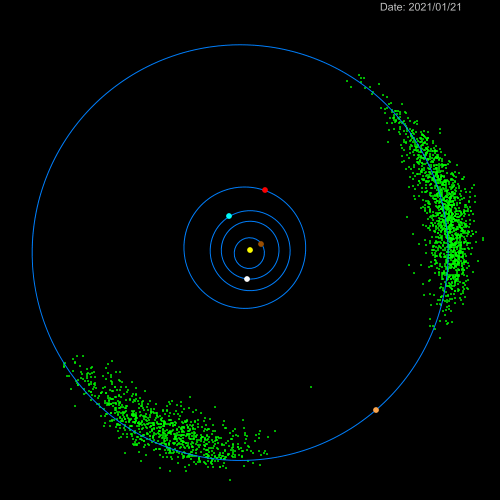
After blasting off from Cape Canaveral, the Lucy spacecraft will spend a year in an orbit around the sun similar to Earth’s, before returning to its home planet next October for a gravity assist slingshot maneuver to begin heading out into the solar system.
“Finding a trajectory that actually will allow us to visit all these types of objects has been a real chore for Lucy,” Levison said “We rattle around the inner solar system using Earth gravity assists to slowly pump up the orbit of the spacecraft so it eventually intersects the orbit of Jupiter.”
Without the Earth gravity assists, Lucy would have to carry five times more fuel, enough to make the mission unfeasible, according to Coralie Adam, deputy chief of the navigation team at KinetX Aerospace.
A second flyby of Earth in December 2024 will send Lucy toward its first asteroid encounter. The spacecraft will speed past asteroid Donaldjohanson, named for the scientist who discovered the Lucy fossil, in April 2025.
Then Lucy will fly into the first Trojan swarm, visiting five asteroids — including a tiny moon of one of the objects — in just 15 months between August 2027 and November 2028. Those five asteroids are in the so-called L4, or Greek, swarm.
At its most distant arc, Lucy will be more than 500 million miles (800 million kilometers) from the sun. The spacecraft will be the farthest spacecraft from the sun to ever rely on solar power.
A final swing by Earth in 2030 will set up Lucy for the last encounter of the 12-year mission, a flyby of a binary pair of asteroids named Patroclus and Menoetius on March 3, 2033, in the L5, or Trojan, swarm. Each of the two objects are about the same size, with diameters of more than 60 miles (100 kilometers), making them the largest targets of Lucy’s solar system sojourn.
At each asteroid, Lucy will have just hours to take the best pictures and gather the most useful data. The probe will zip by the asteroids at a relative velocity of several miles per second, using a swiveling platform to point its camera and science instruments.
“Lucy is a flyby mission, so after spending years traveling more than a billion miles to get to our targets, we aim almost directly at them, flying within 600 miles (1,000 kilometers) of their surfaces,” said Keith Noll, NASA’s project scientist for the Lucy mission. “And Lucy doesn’t slow down for these flybys.”
The spacecraft will zip past each of its asteroid targets at relative speeds ranging from 13,000 mph (21,000 kilometers per hour) to 20,000 mph (32,000 kilometers per hour).
“When you look at these cartoon maps, it looks like those dots that represent the Trojans are pretty close to one another,” Noll said. “But, in fact, the closest pair that we (will visit) is more than 10 million miles apart, and the others are much further than that.”
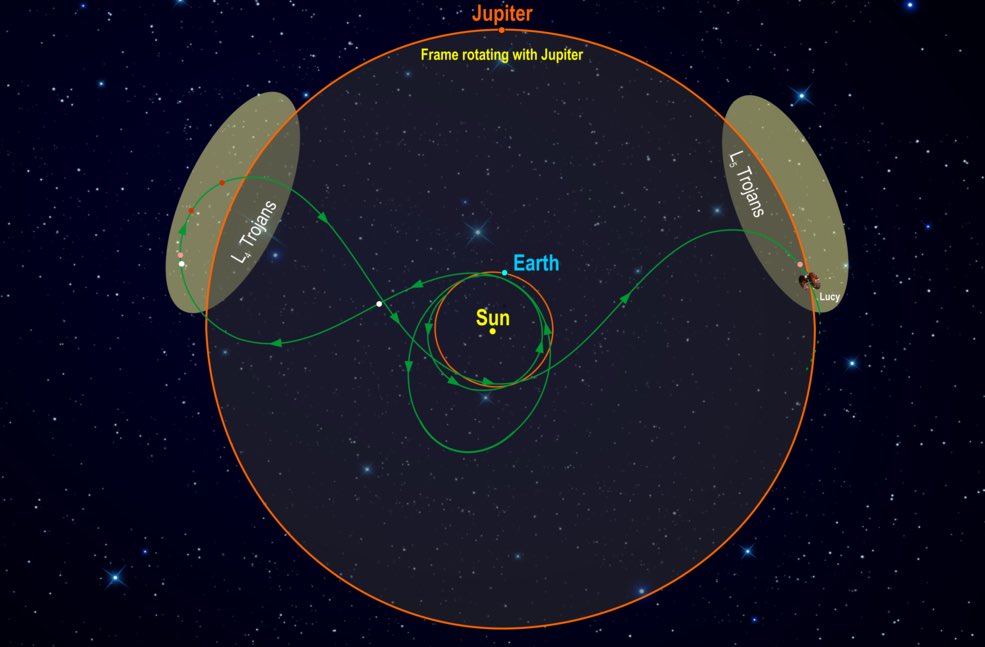
Lucy’s three science instruments are each upgraded versions of payloads flown on previous NASA missions.
One of the instruments, the Lucy Long Range Reconnaissance Imager, is a black-and-white imaging telescope based on a similar instrument on NASA’s New Horizons spacecraft, which captured the first close-up views of Pluto in 2015.
The L’LORRI instrument, provided by the Johns Hopkins University Applied Physics Laboratory, will produce the most detailed images of the Trojan asteroids, mapping their surfaces, surveying craters, and searching for small companion asteroids and dust clouds.
Another payload on the spacecraft comes from NASA’s Goddard Space Flight Center. It’s named L’Ralph, and is two instruments in one.
One element of the instrument is essentially a color camera, producing images with similar appearance to what the human eye would see. An infrared imaging spectrometer will help scientists identify ices, minerals, and organic molecules on each asteroid.
Lucy’s Thermal Emission Spectrometer, or L’TES, instrument will measure the temperature of each asteroid’s surface.
“The temperature tells us a tremendous amount about the physical properties of the surface,” said Phil Christensen, principal investigator for the L’TES instrument from Arizona State University. “By comparing day and night measurements, we can determine is the surface made of dense bouldering material, or fine grain dust and sand.”
Other scientific investigation that is part of Lucy’s mission, but not considered a payload, will help researchers determine the mass of each asteroid, which can yield estimates of the object’s density.
“As we fly past the Trojan asteroids, the acceleration of the gravitational pull of the Trojan asteroids will change the velocity of the spacecraft just a little bit,” Olkin said. “We’re flying by at nearly 15,000 mph past our objects, and the gravitational pull from the Trojan asteroids will change that velocity by about a hundredth of a mile per hour, but we’ll be able to detect that with our telecommunications subsystem and the change in the Doppler frequency as we fly by.”
That velocity change will tell scientists how much mass each asteroid contains.
Lucy’s mission is aimed at answering some serious scientific questions, but mission planners aren’t immune to pop culture.
Lucy, the fossil, received its name after scientists heard the Beatles song “Lucy In The Sky With Diamonds” while celebrating the discovery. Scientists developing the Trojan asteroid explorer saw the connection.
“These asteroids really are like diamonds in the sky in terms of their scientific value for understanding how the giant planets formed and the solar system evolved,” Levison said.
A tiny diamond buried deep inside the L’TES spectrometer acts as a beam splitter, which breaks light apart and sends beams into different directions within the instrument’s focal plane.
“We truly are sending a diamond into the sky with Lucy,” Christensen said. “It’s a fundamental part of the instrument as well as a fun element of the mission.”
Scientists haven’t ruled out sending Lucy to visit more asteroids after the primary mission’s last encounter in 2033. The final Earth flyby will leave the spacecraft in a stable orbit around the sun that requires little propellant to maintain.
Even without an extended mission, Lucy will find its way into the record books.
“We’re visiting more asteroids than any other spacecraft in history,” Levison said. “It’s also a 12-year mission, which is a long period of time.
“I have to say, I’ll be 75 when all this is said and done,” Levison said. “But you can also imagine that young people, people maybe in elementary school and middle school, will be working on Lucy by the time we get to the end of the mission.”
Email the author.
Follow Stephen Clark on Twitter: @StephenClark1.
